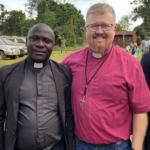
Church Revitalization | Recovering God’s Word

Church revitalization is one of the most difficult undertakings within the life of a local congregation. In the next ten years, church revitalization will become the most important point of conversation for Anglican leaders. Here is my reason for saying this — most Anglican church demographics seem to skew to older generations. One only needs to attend clergy meetings to observe this reality.
If this trend continues, then within the next decade we may see churches closing their doors because they have failed to connect with younger generations.
Rather than waiting until this moment arrives, we need to consider the possibility that now is the time to think through the process of church revitalization.
What is Church Revitalization?
According to Renovate, a ministry dedicated to church revitalization, the definition of revitalization is “the missional work of turning a plateau or rapidly declining church around and moving it back towards growth.”
Two key ideas.
1. Church revitalization is a “missional work.”
What does the word missional mean? Easily understood, it is the idea of reminding, encouraging, and reshaping congregations around the primary purpose of being, sharing, and communicating the gospel or “good news” of Jesus Christ. Missional work is realigning a parish or church back around a central purpose — being a missionary unit in a community, dedicated to sharing the gospel with the church’s neighbors.
Missiologists, those who study Christian mission, helpfully point out that before missionaries may reach a new people group, who have never encountered Christianity, they must first examine the language forms and customs the people use to communicate with one another. Whenever missionaries fail to understand a people’s unique cultural and language forms, then the gospel message is usually rejected. If the gospel is a message, then this means the primary medium of the gospel is spoken, written, and sung.
In our American context, these principles are as relevant today than ever. When pastors are considering who they are trying to minister to and to whom they are called, it naturally follows that taking into account language must be one of the key considerations. That may require reassessing liturgies to see if they are appropriately contextualized to an area.That is foundational work, and it is gospel work.
2. Church revitalization calls for an honest assessment of the conditions of the church.
The second part of the definition is the more difficult challenge – recognizing the church is in decline or has plateaued. Let’s face it; no one wants to admit a parish is in decline. That can be extraordinarily painful. But it may be helpful to remember why churches are planted and why they often fail.
Here it is critical to recognize a statistic from church planting – 80% of church plants fail! That’s helpful because it is a sobering reminder of the high stakes involved in the missional task.
From experience, ministries form for all kinds of reasons, and they likewise fail for much more. Lack of training, underfunding, lack of a ministry target, the lack of vision, or the hardness of the people group trying to be reached, all factor into whether or not a church will successfully launch.
When things go bad or not as planned, it’s easy to blame the founding pastor, blame environmental conditions, and even blame other congregations for its demise. However, it’s tough for a group to accept the brutal reality that the problem may be within the body itself — the sum of congregational worship style preferences, spiritual maturity of its leadership, and the culmination of incremental choices made over an extended period.
Insight at this level is tough to attain. Why? The answer is summed up well by this maxim —
“you can not solve a problem in the system that created it.”
At the most basic organizational level, churches are systems formed together by mutual core beliefs, liturgies, ceremonies, and practices. These characteristics create ecosystems that do not simply cease to exist just because one aspect may have changed. They continue but in an altered form.
Like environmental ecosystems, when sickness or toxins seep into a ministry, the entire ecosystem suffers. The parish shifts from producing, sustaining and flourish, to possibly no longer being capable of life. Unless some intervention addressing the problem occurs, the organizational life, the ministry may dissipate.
A Parable of a Lake
Consider this example, whenever some form of pollution is dumped into a fresh water system, the entire surrounding environment suffers. A perfect example of this is in one of the largest freshwater lakes in the state of Florida, Lake Apopka.
Early in the 20th century, after a season of farming, owners would flood their fields with water taken from Lake Apopka. When it was time to plant a new crop, the water was drained from the fields and pumped back into the lake. High levels of fertilizers and pesticides began to build in the lake as a direct result of these actions. Decades later, the lake’s entire ecosystem was destroyed, and Florida lost one of its most precious natural resources.
Farmers were incapable of solving the damage that was occurring to the lake because their entire livelihood was at stake. To address the problem, people first had to step from the problem to recognize what was happening. The farming techniques that produced vibrant crops were destroying the lake in the process. It required brute honesty by the farmers to see that their action had directly caused the lake’s demise.
Returning to the church, honesty at this level requires ridiculous awareness and an honest assessment of the situation by a pastor and congregation. It can be extraordinarily painful for the church and the leadership; however, if revitalization is going to occur, then candid honesty is needed.
The Anglican Advantage
Anglicans have a unique advantage, our heritage! During the English Reformation, our Anglican forefathers (Cranmer, Latimer, Ridley and others) recognized the same pattern of decline as outlined above and created the tools needed to keep churches on the right direction.
One of the instruments are the classic formularies: The 39 Articles of Religion, The Book of Common Prayer 1662 and the Ordinal. Taken together, these have been the backbone of Anglican orthodoxy since they appeared in the 16th century. These formularies contain biblical truths relevant for today’s church and help in assessing any parish.
An Example
How do these formularies inform Anglican Revitalization? Consider what Article 36 of the Articles of Religion has to say about tradition and “styles of worship.”
“It is not necessary that Traditions and Ceremonies be in all places one, or utterly like; for at all times they have been divers, and may be changed according to the diversity of countries, times, and men’s manners, so that nothing be ordained against God’s Word.”
Notice the concern – nothing be ordained against God’s Word. Regardless of the theological, ceremonial, or linguistic progressions within Anglican history, the standard for worship and gospel ministry always begins by comparing those activities against the revelation of Holy Scripture. The article specifically cautions against elevating certain traditions and ceremonies by democratizing prayer services and turning authority over to individual churches. Likewise, it recognizes diversity and even encourages its expression!
Unlike the Roman Church, Anglicans promote the development of liturgical forms and expressions that are uniquely adapted to the areas where the church is located. That helps us tremendously because it places at the center the need to contextualize our efforts to a given people. In fact, Cranmer’s prayer book was altogether contextualized to 16th century England. Rather than dismissing Cranmer as irrelevant and tied to the problems of his time, Cranmer provides an important model of creating services that engage the ministry context.
Having such a role model should encourage us not hinder us. We should then accept that there is no reason why a revitalization process may not occur.
So where do we start? I think the answer begins with an honest assessment of where things are and the courage to make needed changes, but also recognize that at the very heart of Cranmer’s effort was a pastoral heart who worked slowly and deliberately to evangelize the church with the love of God.
Here are some questions to help you think about revitalization:
1. Do you sense something is wrong? If so, what would you do about it?
2. Is your church failing to reach younger generations? If so, why do you think this failure is occurring?




